The Motorola Atrix 4G Preview
by Anand Lal Shimpi on February 13, 2011 3:18 AM ESTA couple of months ago I had the opportunity to join a bunch of NVIDIA employees for dinner. Among those at the table were Michael Toksvig and Tony Tamasi. Michael, or Tox as he likes to be called, worked on the AA hardware for NV17, NV25, NV40 and G80. He managed to skip NV30. More recently Tox was the chief architect on GeForce ULV, the GPU integrated in NVIDIA's Tegra 2 SoC.
Tony Tamasi is someone I've known for around a decade. I first met him while he was working at 3dfx, and got the pleasure of working closely with him when he later moved to NVIDIA to do technical marketing. Both Tox and Tony are very passionate engineers at heart and are up for a good conversation.
The conversation we had at dinner that night was on the future of the smartphone and the mainstream PC. Tony argued that technically, within 3 years, a high end smartphone will be able to offer the performance of a (low end) mainstream PC today. Admittedly that isn't the highest bar possible as virtually everything above a netbook falls into that category, but it's a valid claim.
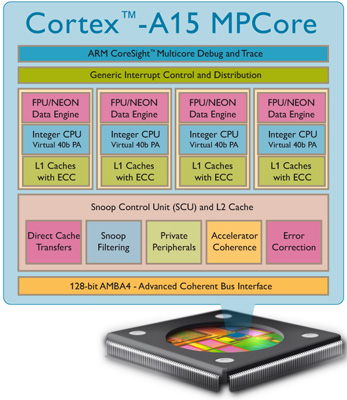
ARM's recently announced Cortex A15 should be able to outperform Intel's current generation Atom depending on clock speed/core count configurations. Add another generation beyond that and you might have the performance of a mainstream PC today, at least the lower end of the mainstream segment.
Tony further admitted that although it would be technically feasible for mainstream PC users to replace their PCs with smartphones in three years, there are a number of other things that will likely prevent such a thing from happening too quickly. But he was confident that within the next 10 years, mainstream PCs will be nothing more than smartphones tethered wirelessly to a monitor, keyboard and mouse. When you're done at your desk you'll just pick up your smartphone and carry it with you.
Note that this future only pertains to mainstream PCs (e.g. sub-$500 market). There's still an obvious benefit to having a larger chassis that can accommodate higher transistor counts and higher TDPs.
I've heard other PC companies offer similar visions of the future, although they all disagree on the timeframe. I've heard periods as short as 5 years and as long as 20 years. Predictions have a nasty habit of not taking the unpredictable future into consideration, but this is definitely a valid possibility for the next decade or so.
It wasn't a coincidence that we had this conversation at dinner some months ago. Tony knew what was being announced at CES.
Jen-Hsun Takes the Stage
Jen-Hsun's CES keynote was probably the best I'd seen him do in recent history. The last time I heard Jen-Hsun speak was at the first and only NVISION conference. His keynote at the time was about the importance of GPUs and the role they'll play in future computing devices. The keynote was bland. It ignored the obvious need for a a balance of good CPU *and* GPU technology. It was everything we've grown to despise about NVIDIA - Jen Hsun spoke about a world where GPUs and NVIDIA were driving the entire computing industry forward. He spoke about a world that didn't exist.
Jen-Hsun at CES 2011 was more like the old Jen-Hsun. There was more passion, more belief, less BS. But he was also a more mature Jen-Hsun. He still took his jabs at x86 and the Wintel alliance, but he offered better perspective - not just an injection of whatever NVIDIA cooked up in the basement the other night.
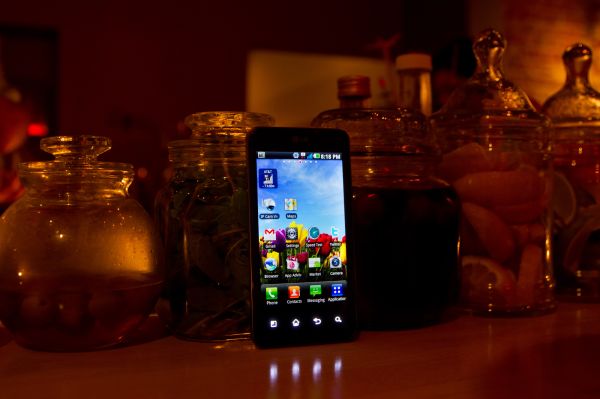
LG's Optimus 2X - The first Tegra 2 smartphone
At CES 2011 NVIDIA finally announced the first smartphone based on its Tegra 2 SoC: LG's Optimus 2X. Motorola followed up with three more Tegra 2 based devices. And although Google didn't make a big deal out of it at the show, NVIDIA also has the honor of being the official SoC partner on the Honeycomb release of Android. The first OEMs to launch Honeycomb tablets will be running NVIDIA Tegra 2 SoCs.
NVIDIA also announced its intentions to plug the gaping hole in its future. The company is an ARM architecture licensee, and Project Denver will be its first high performance CPU design.
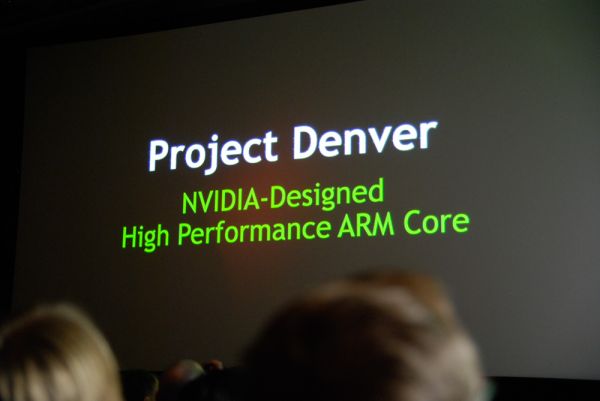
If high end smartphones will begin to replace mainstream PCs, NVIDIA needs to offer a compelling CPU, GPU and overall SoC for that market. Jen-Hsun always understood the importance of the OEMs in gaining traction in the PC market, and OEMs tend to want to have the best hardware possible. In order to give them that, NVIDIA can't simply ship an off-the-shelf ARM core, it needs something better than that.
So what's the point of all of this?
If smartphones are moving up in the world and will eventually be powerful enough to drive a high resolution display and run mainstream computing tasks, the evolution has to start now. There are usually a bunch of failed attempts and baby steps before we finally arrive at the product that just clicks. Look no further than the smartphone market for proof of that. It took years of PDAs and crap phones before we got to things like the Droid, the iPhone and the Palm Pre.
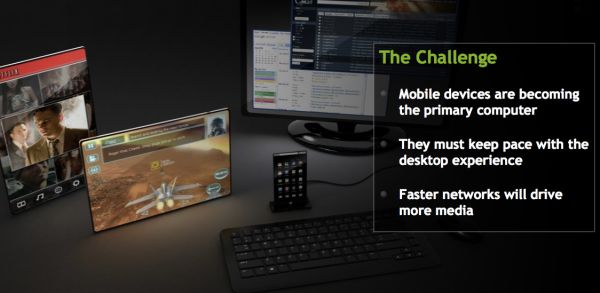
The battle for the advancement of smartphones has begun, and Motorola just fired the first shot.
LG announced and began shipping the world's first Tegra 2 based smartphone, however it looks and behaves much like any other Android phone - just faster.
Motorola's flagship Tegra 2 device is a little different. At CES Motorola announced the Atrix 4G as a dual-core superphone with 1GB of RAM and a 1930mah battery. I was worried that this meant the Tegra 2 couldn't be trusted on a battery, but LG proved me wrong. The point of the extra large battery and the ridiculous memory capacity is because Motorola wants the Atrix 4G to be more than just a smartphone. It wants it to compete with a netbook.
Don't get me wrong. What Motorola wants and the reality that exists don't exactly line up. A netbook will still give you a better computing experience, particularly something based on AMD's latest Brazos platform. But as I mentioned earlier, a revolution has to start somewhere.
A couple of days ago I got a package from Motorola. In it was the Atrix 4G, a multimedia dock, bluetooth keyboard and mouse. I'm currently on a flight to Barcelona to join Brian Klug as we cover Mobile World Congress for the first time on AnandTech. MWC is a very large mobility focused tradeshow that's held yearly. From a content standpoint it's like a smartphone/tablet CES.
It takes days for us to run through all of our battery life tests, and usually a couple of weeks of constant usage for us to put together one of our smartphone reviews. With Brian working on the Verizon iPhone 4 and both of us en route to MWC, it'll be a little while before we can bring you a full, in-depth Atrix 4G review.
That being said I wanted to get some of my thoughts out there as this is a highly anticipated device that attempts to do a lot.
What follows is by no means a full review, I wouldn't dream of calling it that. But rather an account of my experiences with Motorola's Atrix 4G thus far. Give me some time after MWC and we'll get a full review up. The Atrix hasn't left my side since it arrived and I'll be using it to keep up with emails and schedule meetings at the show as well. Be sure to read our Optimus 2X Review for more coverage on what makes up NVIDIA's Tegra 2 SoC.


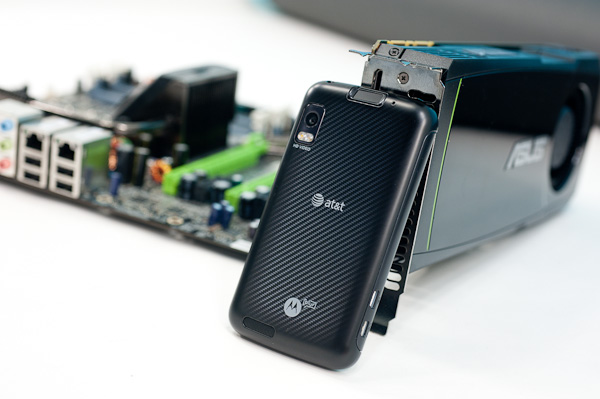
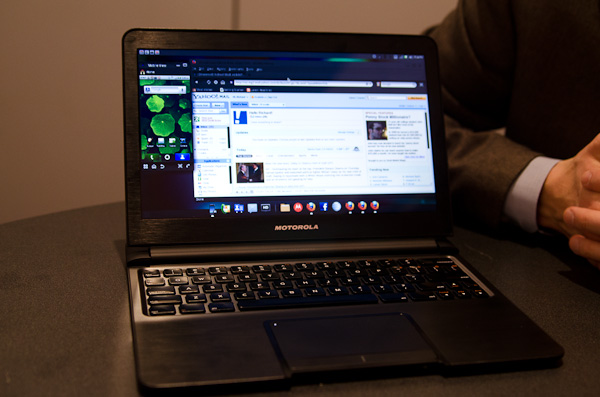
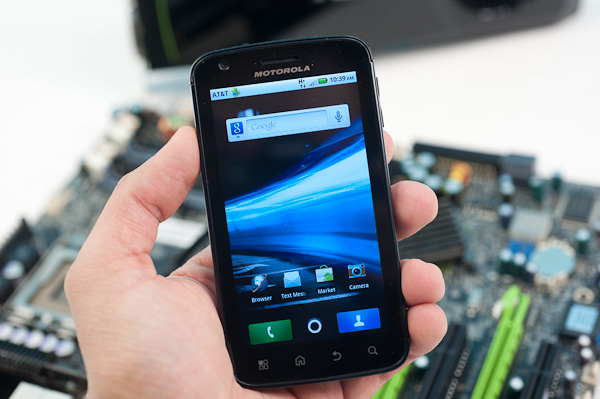








41 Comments
View All Comments
evan919 - Sunday, February 13, 2011 - link
Hi Anand,The reason the Atrix 4G (and consequently the Inspire 4G) suffer from UMTS-sh upload speeds is because AT&T requests the handset manufacturer to disable HSUPA. The same thing occured with every smartphone besides the iPhone 4 on AT&Ts network. I have a Captivate that has HSUPA enabled by flashing the modem firmware with an HSUPA enabled firmware. Just a little insight. I'm enjoying the review.
http://emuneee.com/2011/02/is-att-disabling-hsupa-...
shabby - Sunday, February 13, 2011 - link
Those are just pathetic speeds, 4g my ass att. Im getting 6mbps down and 3mbps up on rogers 3g network with my captivate using bells unlocked hspa modem.FrozenAsset - Sunday, February 13, 2011 - link
Unless I'm missing something, why waste money on a dock? Can you bypass a dock completely?Can you not just provide your own keyboard / mouse and attach by USB hub or connect by Bluetooth?
It comes with it's own HDMI cable, cant you use that to connect to an HDMI monitor or TV and browse the web at the same time without also paying for tethering?
The dock I have for my Panasonic TV / iPod is a dumb dock, no chip, no software just a place to sit it and connect to the TV. Why would anyone spend that kind of money on something like that?
Mumrik - Sunday, February 13, 2011 - link
It's up to you whether you'll take this as a compliment (personally) or an insult (to the site), but Anand, you are by far the best writer at Anandtech. I'm far more likely to read every word of an article if you wrote it, and as I started to read this one I was immediately able to tell that you were the author.SpartanJet - Sunday, February 13, 2011 - link
On the "The qHD Screen: A Pentile LCD?" you have a thumbnail of both the iPhone LCD and the Atrix LCD unfortunately when you click on the thumbnail they both link to the same picture.I'm really interested in this phone but the screen seems like I'd fall into the "it would bug me" group. I pre-ordered this phone now looking at that screen I'm starting to have my doubts. I think the screens are the 2nd most important feature on these smartphones.
JCheng - Sunday, February 13, 2011 - link
What's the first most important feature?notposting - Sunday, February 13, 2011 - link
Hey Anand,I thought I remember seeing that the power button doubles as a fingerprint scanner on the Atrix but I didn't see you mention it.
Interesting perspective on how things work in the technological fields...this may be the first of it's kind but probably won't be the one that really hits that balance of price and performance just yet...nice demonstration unit though.
Also agree with the other poster...very well written article. :)
PubicTheHare - Sunday, February 13, 2011 - link
Anand,I didn't see a reference to the bootloader. I know Moto likes to lock it up (Droid X, Droid 2). Any idea if they did it with the Atrix?
If so, we can assume they will do it with the Bionic (please preview this one, too!).
Have fun at MWC!
sid1712 - Monday, February 14, 2011 - link
Anand, you've written that the OptimuxS2X has 4" Super AMOLED display instead of the IPS LCD that it has.Also, it would be great if you would give your opinion on the call quality via the earpiece and the loudspeaker quality. Do the dual microphones improve the call quality significantly ?
Cheers
TareX - Tuesday, February 15, 2011 - link
I'm extremely disappointed with the PenTile LCD.... even Samsung fixed that with the new SAMOLED PLUS displays... I knew there had to be catch with the Atrix 4G.I'm even more disappointed with the contrast and brightness... isn't anything competitive with Apple's IPS? I'm starting to believe Apple really does make the best hardware decisions.
I am disappointed.... I like Motoblur, actually. I would take it over anything LG makes. Sigh.